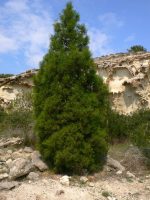 Also called citrus wood by the ancient Romans, this evergreen shrub or small tree is native to the Atlas Mountains of North Africa and is a member of the cypress family, Cupressaceae, that also includes juniper, arborvitae, and redwood. The multistemmed plants grow 20-50′ tall but rarely exceeds 30′ and have a pyramidal habit when young. The bark is grayish brown and scaly, cinnamon beneath if exposed by exfoliation. The branches form flat open sprays and carry whorls of small scale-like leaves. Male and female cones appear on the same tree; the female cones are about 1/2″ long, have 2 opposite pairs of thick scales, and sometimes bear a white blume. The male cones are only .16″ long. Sandarac gum tree responds positively to coppicing, can be clipped into a hedge as well as used as a windbreak, screen or bonsai. The dark colored fragrant wood takes a high polish and has been valued since antiquity for making furniture. The genus name, Tetraclinis, is from the Greek words tetra meaning four and kline meaning bed and refers the fact that the leaves grow in groups of 4. The specific epithet, articulata, is the classical Latin word meaning jointed.
Also called citrus wood by the ancient Romans, this evergreen shrub or small tree is native to the Atlas Mountains of North Africa and is a member of the cypress family, Cupressaceae, that also includes juniper, arborvitae, and redwood. The multistemmed plants grow 20-50′ tall but rarely exceeds 30′ and have a pyramidal habit when young. The bark is grayish brown and scaly, cinnamon beneath if exposed by exfoliation. The branches form flat open sprays and carry whorls of small scale-like leaves. Male and female cones appear on the same tree; the female cones are about 1/2″ long, have 2 opposite pairs of thick scales, and sometimes bear a white blume. The male cones are only .16″ long. Sandarac gum tree responds positively to coppicing, can be clipped into a hedge as well as used as a windbreak, screen or bonsai. The dark colored fragrant wood takes a high polish and has been valued since antiquity for making furniture. The genus name, Tetraclinis, is from the Greek words tetra meaning four and kline meaning bed and refers the fact that the leaves grow in groups of 4. The specific epithet, articulata, is the classical Latin word meaning jointed.
Type: Evergreen shrub or small tree
Outstanding Feature: Wood
Form: Pyramidal
Growth Rate:Slow
Bloom:Not applicable
Size: 20-50′ H x 9-15; W
Light: Full sun
Soil: Average, dry, well-drained; very drought tolerant and tolerates slightly saline soil.
Hardiness: Zones 9-11
Care: Low maintnenace
Pests and Diseases: None of significance
Propagation:Seed, cuttings
Photo Credit: Wikimedia Commons